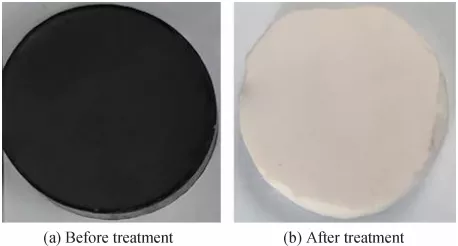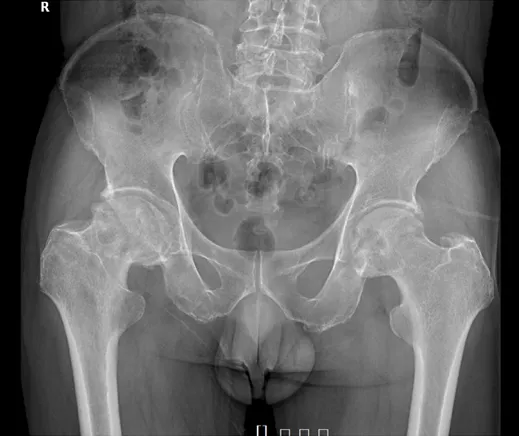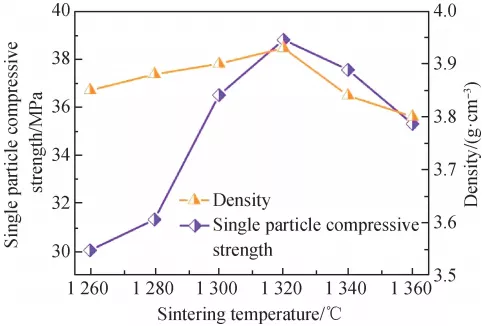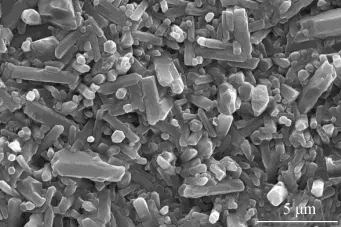Abstract: (Ba0.3Sr0.7)x(Bi0.5Na0.5)1-xTiO3 (BSxBNT, x = 0.3–0.8) ceramics were prepared to investigate their structure, dielectric and ferroelectric properties. BSxBNT ceramics possess pure perovskite structure accompanied from a tetragonal symmetry to pseudo-cubic one with the increase of x value, being confirmed by X-ray diffraction (XRD) and Raman results. The Tm corresponding to a temperature in the vicinity of maximum dielectric constant gradually decreases from 110 ℃ (x = 0.3) to –45 ℃ (x = 0.8), across Tm = 36 ℃ (x = 0.5) with a maximum dielectric constant (ɛr = 5920 @1 kHz) around room temperature. The saturated polarization Ps gradually while the remnant polarization Pr sharply decreases with the increase of x value, making the P–E hysteresis loop of BSxBNT ceramics goes slim. A maximum difference between Ps and Pr (Ps–Pr) is obtained for BSxBNT ceramics with x = 0.5, at which a high recoverable energy density (Wrec = 1.04 J/cm³) is achieved under an applied electric field of 100 kV/cm with an efficiency of η= 77%. Meanwhile, the varied temperature P–E loops, fatigue measurements, and electric breakdown characteristics for the sample with x = 0.5 indicate that it is promising for pulsed power energy storage capacitor candidate materials.
Keywords: energy storage ceramics; Ba0.3Sr0.7TiO3 (BST); Bi0.5Na0.5TiO3 (BNT); relaxor ferroelectrics; pulsed power capacitor
1 Introduction
The rapid development of power electronics industry promotes an effective exploitation and utilization for clean and renewable energy. New energy storage materials, core components with both high energy density, and power density in particular, are highly expected but encountered many challenges [1–3]. Basically, chemical power sources such as batteries and solid oxide fuel cells have high energy storage density but low power density, which are not suitable for pulsed power electronics applications. On the contrary, physical power sources such as dielectric capacitors have high power density (on the order of MW) and ultrafast charging-discharging capability (about microseconds or even nanoseconds), while its low energy storage density needs to be further improved to meet the compact and miniaturized requirements of pulsed power system [1,4,5]. Generally, the recoverable energy density per unit volume for dielectric capacitors can be evaluated by the integral formula based on the P–E hysteresis loops:

where E is the applied electric field, Pmax is the maximum polarization (normally alternative to the saturated polarization Ps), and Pr is the remnant polarization [6,7]. Meanwhile, the energy efficiency can be described by the formula:

where Wloss means the energy loss during discharging process and equals to the closed area of P–E hysteresis loop. In this regard, slim P–E hysteresis loops with as high Ps and low Pr as possible should be desirable to achieve both high energy storage density and efficiency [8].
Bismuth sodium titanate (Bi0.5Na0.5TiO3, BNT) shows normal ferroelectric behavior with a very large saturated polarization (Ps > 40 μC/cm²) [9]. However, BNT also has a very large remnant polarization (Pr ≈38 μC/cm²), which makes its P–E hysteresis loop showing fat shape unsatisfied for energy storage applications [10]. In recent years, BNT modifications, such as doped by (Sr,Bi)TiO3 (SBT), (K,Na)NbO3(KNN), or SrTiO3 (ST), have been extensively studied to reduce its Pr markedly and enhance breakdown strength, thus achieving high recoverable energy density [9,11–17]. Meanwhile, BNT is lead-free, which is highly expected to replace the widely used relaxor ferroelectric Pb-containing systems in ceramic capacitor applications [18]. However, it should be pointed out that the modification of BNT has significantly reduced its Pr, but Ps has also decreased a lot at the cost of
dielectric constant. The dielectric constant is critical to compact pulsed power ceramic capacitors, because higher dielectric constant can lead to a shorter length of pulse forming lines [19]. Therefore, it is very important to keep Ps as high as possible when Pr of BNT is significantly reduced by modification.
In our previous work, paraelectric Ba0.3Sr0.7TiO3 (BST) ceramics was thought to be a promising solid state pulsed power capacitor material [20,21]. BST shows low Curie temperature (Tc = –85 ℃); however, its room temperature dielectric constant (ɛr ≈ 650 @1 kHz) is still relatively low. Therefore, we developed a BST–BNT solid solution, i.e., (Ba0.3Sr0.7)x(Bi0.5Na0.5)1–xTiO3 (BSxBNT) to improve the dielectric constant at room temperature. Meanwhile, the structure, dielectric and ferroelectric properties of BSxBNT ceramics were investigated to evaluate its energy storage characteristics suitable for pulsed power capacitor applications.
2 Experimental
(Ba0.3Sr0.7)x(Bi0.5Na0.5)1-xTiO3 (BSxBNT, x = 0.3, 0.35, 0.4, 0.45, 0.5, 0.6, 0.7, 0.8) ceramics were prepared by a solid state reaction route using barium carbonate (BaCO3, 99%), strontium carbonate (SrCO3, 99%), bismuth oxide (Bi2O3, 99%), sodium carbonate (Na2CO3, 99.8%), and titanium dioxide (TiO2, 98%) as raw materials, which were purchased from Sinopharm Chemical Reagent Co., Ltd., Shanghai, China. For each composition, the raw powders were dried at 100 ℃ for 24 h to remove moisture before weighing, and then weighed according to the stoichiometric formula and milled in ethanol medium with ZrO2 balls for 24 h. The mixed slurry was dried and calcined in air at 900 ℃ for 3 h, and then milled again for 24 h. After drying, the calcined powders were granulated by adding polyvinyl alcohol solution (PVA, 5 wt%) as binder, and then prepressed into pellets of 13 mm in diameter and about 1 mm in thickness under 120 ±10 MPa followed by a cold isostatic pressing. The green pellets were first preheated at 650 ℃ for 2 h to remove PVA binders, and then sintered at 1240–1340 ℃ for 2 h in air. In order to minimize the volatilization of Bi and Na, the pellets were embedded in self-source powders during high temperature sintering process.
The phase structure of the sintered ceramics was determined by an X-ray diffraction meter (XRD, D8-Advance, Bruker, Germany) using Cu Kα radiation (λ = 0.15406 nm). The XRD profiles were analyzed by Jade software. Raman spectroscopy was measured by a Raman spectrometer (LabRAM HR800, HORIBA) at room temperature using laser excitation at 532 nm wavelength to probe the variation of phonon vibration modes. The Raman spectrum was decomposed by Lorentz peak fitting. The microstructural characteristics of polished and thermally etched surface of the sintered ceramics were observed by scanning electron microscopy (SEM, JSM-6700F, JEOL, Japan). For electrical measurements, the sintered pellets were both side polished and painted with silver pastes, and then fired for 30 min at 800 ℃ to form electrodes. The dielectric properties were measured using a precision impedance analyzer (HP4294A, Agilent) over a temperature range from –100 to 400 ℃, being connected to a computer controlled temperature chamber, to collect data at testing frequencies of 1 kHz, 10 kHz, 100 kHz, and 1 MHz. To measure ferroelectric properties, ceramic samples were polished to a thickness of 0.3–0.35 mm and covered a central electrode of area about 0.5 cm² with margin. The room temperature P–E hysteresis loops were examined using a Radiant precision workstation (TRek model 609B) based on a standard Sawyer–Tower circuit at 10 Hz. The temperature-dependent P–E hysteresis loops were measured by using an aixACCT TF2000 FE-HV ferroelectric test unit from 20 to 180 ℃. The energy storage density and efficiency were evaluated by integrating the area between the polarization axis and the discharge curve in the P–E hysteresis loop of the ceramic samples.
3 Results and discussion
As analyzed from the XRD patterns of BSxBNT ceramics given in Fig. 1(a), all ceramic samples are indexed a pure perovskite structure without any secondary phases, indicating that BST and BNT can form a continuous solid solution. As seen from the enlarged pattern around 2θ = 46.3° shown in Fig. 1(b), the splitting peaks (002)/(220) for the sample with x = 0.3 are merged into a nearly single peak (200) for the samples with x ≥ 0.35, which indicates phase transition from tetragonal symmetry to pseudo-cubic one. Meanwhile, the (200) peak slightly shifts to lower angle with the increase of x value. This should be owing to the expanding of unit cells caused by the substitution of Ba0.3Sr0.7 with larger average ionic radius of 1.49 Å ( rBa2+=1.61 Å, rSr2+=1.44 Å, CN= 12) for Bi0.5Na0.5 with smaller average ionic radius of 1.42 Å ( rBi3+ = 1.45 Å, rNa+= 1.39 Å, CN = 12) [22].

Fig. 1 XRD patterns of BSxBNT ceramics.
To further study the phase composition variation of BSxBNT ceramics, Raman spectroscopy, as a complement way of XRD technique, is applied to investigate local phase structure characteristics. As seen from Fig. 2(a), all Raman patterns of BSxBNT ceramics at room temperature have similar configurations, while the position and intensity of the Raman peaks vary with x value. Accordingly, the Raman patterns are decomposed by Lorentz peak fitting to investigate the effect of x value on the vibration modes. The fitted Raman patterns for the represented BSxBNT ceramics with x = 0.3 and x = 0.6 are shown in Figs. 2(b) and 2(c), respectively. Figure 2(b) displays that the Raman pattern can be well fitted and decomposed into eight independent Raman peaks, in agreement with Ref. [23]. However, a new mode appears when x ≥ 0.6 and the Raman pattern can be well fitted and decomposed into nine independent Raman peaks, as shown in Fig. 2(c). All fitted independent Raman peaks are marked from ν1 to ν9 according to the increase of wave number, and the relationship between them and x value is given in Fig. 3.

Fig. 2 (a) Raman patterns of BSxBNT ceramics at room temperature, (b) Lorentz peak fitting of Raman pattern for BSxBNT ceramics with x = 0.3, and (c) Lorentz peak fitting of Raman pattern for BSxBNT ceramics with x = 0.6.
According to group theory analysis, BNT had been predicted 16 active modes, ΓRaman = 4A1 + 1B1 + 3B2 + 8E for the tetragonal symmetry (P4bm, C4v2 , Z = 2) [24]. For BSxBNT ceramics, as seen from Fig. 3, the modes of wavenumbers ≤ 200 cm–1 should be associated with the vibration of cations in A-site [25,26]. It is believed that the mode v1 around 138 cm–1 should be related to the vibration of Na+TiO3 rather than Bi3+TiO3 one due to the larger Bi mass [27,28], and a little wavenumber fluctuation for the mode v1 may result from the effect of disorder distribution of Ba/Sr/Bi/Na cations in A-site. The mode v3 and a new mode v2 should be associated with the vibration of Ba–O/Sr–O bond similar to Ref. [23]. Due to the A1 symmetry sensitive to the phase transition, the appearance of new mode v2 may be a sign of local structure change, relating to tetragonal symmetry to pseudo-cubic one as analyzed in Fig. 1. The modes around 200–400 cm–1 are closely related to the vibration of Ti–O bond, which is usually considered to change dielectric properties for perovskite systems [29,30]. The modes v4 and v5 exhibit a soft-mode like behaviors as they gradually shift toward lower wavenumbers, which can be ascribed to the ascending structure disorder and decreasing unit cell polarity with the increase of BST content. The modes v6 and v7 in the wavenumber region of 400–700 cm–1 are correlated with [TiO6] octahedra vibration [12].It can be seen that the wavenumber of v6 mode basically keeps stable, while that of v7 presents an obvious shifting downward tendency with the increase of BST content. Especially, the intensity of mode v7 reduces markedly when BST content x ≥ 0.6 as shown in Fig. 2, which should be owing to the dominant of pseudo-cubic phases. In the high wavenumber ranges of ≥ 700 cm–1, the two modes v8 and v9 are corresponding to the overlapping of A1 (LO) and E (LO) bands [23].

Fig. 3 Wavenumber of Raman peaks from ν1 to ν9 of BSxBNT ceramics as a function of x value.
Figure 4 shows the SEM images of BSxBNT ceramics. For BSxBNT ceramics with x = 0.3, as shown in Fig. 4(a), the grain size is 3–5 μm. With the increase of BST content up to x = 0.5, as shown from Fig. 4(b) to Fig. 4(e), the grain size gradually slightly decreases to 1–2 μm, and then the grain size increases a little again when x ≥ 0.6 (Figs. 4(f) and 4(h)). It can be seen that all ceramics exhibit dense microstructure with homogeneous grain size distribution.

Fig. 4 SEM images of the polished and thermally-etched BSxBNT ceramics: x = (a) 0.3, (b) 0.35, (c) 0.4, (d) 0.45, (e) 0.5, (f) 0.6, (g) 0.7, and (h) 0.8.
Figure 5 shows the temperature dependent dielectric constant and loss of BSxBNT ceramics over the measuring temperature from –100 to 400 ℃. It can be seen that the maximum dielectric constant presents an obvious downward tendency with the increase of BST content. Meanwhile, the temperature in the vicinity of maximum dielectric constant (Tm) almost linearly decreases with the increase of x value as shown in the inset of Fig. 5. For example, the Tm is 110 ℃ for the sample with x = 0.3, while it decreases to –45 ℃ for the sample with x = 0.8. Particularly, for BSxBNT ceramics with x = 0.5, the Tm (36 ℃) is around room temperature with a maximum dielectric constant ɛr = 5920.

Fig. 5 Temperature dependent dielectric constant and loss of BSxBNT ceramics over the measuring temperature from –100 to 400 ℃. The inset shows the temperature in the vicinity of maximum dielectric constant (Tm) as a function of x value.
It is well known that relaxor ferroelectrics have two obvious characteristics: the first one is the Tm shifts toward high temperature as frequency increases, and the second one is the dielectric constant at Tm decreases with the increase of frequency [31]. It should be noted that the dielectric constant of normal ferroelectric follows the Curie–Weiss law at temperature above Tm; however, the relaxor ferroelectric deviates from the Curie–Weiss law and follows the modified model [32,33]:

where ɛr is the relative dielectric constant, T is the absolute temperature, Tm is the absolute temperature at which the maximum dielectric constant ɛm is obtained, C is the Curie constant, and γ is the diffuseness factor which describes the relaxor degree of relaxor ferroelectric apart from normal ferroelectric. The γ value is 1 for normal ferroelectric, while 2 for the ideal relaxor ferroelectric. Figures 6(a)–6(c) show the temperature dependent dielectric properties of BSxBNT ceramics with x = 0.3, 0.5, and 0.8 at different measuring frequencies, respectively. It can be clearly seen that the BSxBNT ceramics with x = 0.3 presents an obvious relaxor feature. However, the relaxor feature gradually diminishes with BST content increases. The fitted pattern of ln(1/ɛr – 1/ɛm) versus ln(T – Tm) for BSxBNT with x = 0.3, 0.5, and 0.8 at 1 kHz is given in Fig. 6(d). The γ value decreases from 1.88 for the sample with x = 0.3 to 1.41 for x = 0.8, indicating a weaken relaxation behavior can be induced by adding BST into BNT matrix. Actually, the variation of relaxation behavior corresponding to a reduced relaxor degree should be owing to the structure evolution from tetragonal symmetry to pseudo-cubic one with the increase of BST doping content as analyzed in Figs. 1 and 2.

Fig. 6 Temperature dependent dielectric properties of representative BSxBNT ceramics at different measuring frequencies of 1 kHz, 10 kHz, 100 kHz, and 1 MHz: x = (a) 0.3, (b) 0.5, and (c) 0.8. (d) gives fitted pattern of ln(1/ɛr – 1/ɛm) versus ln(T – Tm) for BSxBNT with x=0.3, 0.5, and 0.8 at 1 kHz.
Figure 7 shows the P–E hysteresis loops of BSxBNT ceramics with different x values measured under an electric field of 80 kV/cm. For the sample with x = 0.3, the P–E loop presents typical shape of ferroelectrics. However, the P–E loop seems to be clamped to go slim, represented by the remnant polarization Pr significantly decreases from 25.4 μC/cm² (x = 0.3) to 7.3 μC/cm²(x = 0.35) almost without sacrifice of saturated polarization Ps. Furthermore, it should be noticed that Ps has a sharp decrease from 29.3 to 17.8 μC/cm² when x value increases from 0.5 to 0.6, and then the
P–E loops go slim and are almost similar to that of linear dielectrics when x ≥ 0.6. However, the mechanism of P–E loop going slim for BNT-based
materials by different modification is controversial. Cao et al. [34] found a similar phenomenon using SrTiO3 (ST) as a modification, and thought it may be related to the partial coupling effect of a rhombohedral ferroelectric phase with the pseudo-cubic (tetragonal) paraelectric phase, and finally transform into an antiferroelectric phase. For the modification of NaNbO3 (NN), Xu et al. [10] considered the behavior should be associated with the disturbing of ferroelectric order, leading to a ferroelectric-to-relaxor state transformation, and then the paraelectric phase can be formed at room temperature. In contrast, Qi and Zuo [35] plotted the phase diagram from the dielectric properties and thought the slim behavior should result from the phase change at room temperature from nonergodic relaxor ferroelectric to ergodic relaxor ferroelectric, and then to a relaxor antiferroelectric.
Actually, such phase transition between nonergodic and ergodic was also reported in BiFeO3-based materials [36]. Despite these controversies, the
ferroelectric behavior is indeed closely related to the domain evolution induced by phase transition. Combined with the analysis of XRD and Raman
spectroscopy shown in Figs. 1 and 2, the P–E loops gradually go slim with the increase of BST content, which may be associated with the different ions randomly occupy the same equivalent crystallographic site of perovskite structure, breaking the long-range ferroelectric order and generating different domain structure. The domain evolution of BSxBNT ceramics may be varied from macrodomain (x = 0.3) to microdomain (0.35 ≤ x ≤0.5), and finally the nanodomain (x ≥ 0.6), or even the domain gradually disappears when the composition is approaching BST end member.

Fig. 7 P–E hysteresis loops of the BSxBNT ceramics with different x values at room temperature.
The calculated energy efficiency and recoverable energy density of BSxBNT ceramics at room temperature as a function of applied electric field are illustrated in Figs. 8(a) and 8(b). It is obvious that the energy efficiency gradually increases with the increase of x value, which should be resulted from the P–E loops going slim and even linear like as shown in Fig. 7. However, as seen from Fig. 8(b), the recoverable energy storage density firstly increases with increasing x value, reaches maximum value when x = 0.5, and then drops with further increase of x value. This phenomenon should be related to the maximum Ps–Pr value obtained at x = 0.5, as shown in Fig. 8(d). According to the basic theory, for energy storage dielectrics, the higher Ps, the smaller Pr, i.e., the larger the Ps–Pr, the larger recoverable energy density will be acquired [37,38]. Figure 8(c) displays that BSxBNT ceramics with x = 0.5 possesses slim P–E hysteresis loop with both high Ps and low Pr, which demonstrates it is very promising for pulsed power energy storage capacitor materials. Under an applied electric field of 100 kV/cm, a high recoverable energy density Wrec = 1.04 J/cm³ with a moderate efficiency of η= 77% is achieved in BSxBNT ceramics with x = 0.5.

Fig. 8 (a) Energy storage efficiency and (b) recoverable energy density of BSxBNT ceramics as a function of applied electric field. (c) P–E hysteresis loops of a representative BSxBNT ceramics with x = 0.5 under different applied electric fields. (d) Room temperature polarization and Ps–Pr as a function of x value for BSxBNT ceramics measured at 80 kV/cm.
Figure 9(a) shows the temperature dependent P–E hysteresis loops from 20 to 180 ℃ for the represented BSxBNT ceramics with x = 0.5 under 80 kV/cm. The P–E loops can retain a slim shape as the temperature increases up to 180 ℃. However, as seen from Fig. 9(b), the Wrec presents a slightly decrease as temperature increases, which should be related to the decrease of Ps shown in Fig. 9(a). It is well known that the fatigue properties are important to the dielectric material applications [37–40], and thus the corresponding fatigue cycling of BSxBNT ceramics with x = 0.5 was conducted at electric field of 40 kV/cm, 10 Hz, and room temperature. After an indexed fatigue cycling number, the P–E hysteresis loop was also measured at electric field of 80 kV/cm and frequency of 10 Hz and shown in Fig. 9(c). It can be seen that the evolution of Ps and Pr for the sample with x = 0.5 presents almost unchanged with the increase of fatigue cycles, indicating a very good fatigue behavior under an external field. The Weibull distribution of breakdown strengths for ceramic dielectrics is usually used to illustrate the electric breakdown characteristic, which can be expressed by the function relationship between Yi and Xi:

where Ei is the electric breakdown strength of ceramics, i is the sample number, and n is the total sample number. As shown in Fig. 9(d), the experimental data of represented BSxBNT ceramics with x = 0.5 are well fitted with Weibull distribution and a linear relationship can be obtained between Yi and Xi. The average Eb and β are extracted as 113 kV/cm and 8.2, respectively. The value of average Eb for the sample with x = 0.5 is basically similar to those reported in other BNT-based ceramics [9,13,37].

Fig. 9 (a) P–E hysteresis loops and (b) corresponding Ps, Pr, and the recoverable energy density Wrec of BSxBNT ceramics with x = 0.5 measured from 20 to 180 ℃ applied an electric field of 80 kV/cm. (c) The fatigue properties of BSxBNT ceramics with x = 0.5. (d) Weibull distribution analysis of breakdown strengths for the samples with x = 0.5.
4 Conclusions
In this work, (Ba0.3Sr0.7)x(Bi0.5Na0.5)1-xTiO3 (BSxBNT) ceramics were prepared to investigate the effect of BST doping on the structure and energy storage properties. A temperature in the vicinity of maximum dielectric constant Tm gradually decreases with BST content, across around room temperature (Tm = 36 ℃) for the composition of x = 0.5, at which a maximum dielectric constant (ɛr = 5920 @1 kHz) was achieved. With the increase of BST content x value, the Ps gradually but Pr sharply decrease, making the P–E loops of BSxBNT ceramics go slim suitable for pulsed power energy storage application. For the BSxBNT ceramics with x = 0.5, a maximum difference between Ps and Pr (Ps–Pr) was obtained accompanied by a high recoverable energy density (Wrec = 1.04 J/cm³) and a moderate efficiency (η= 77%) under an applied electric field of 100 kV/cm. Furthermore, the temperature stability of energy storage properties, fatigue properties, and electric breakdown characteristics for BSxBNT ceramics with x = 0.5 demonstrate it suitable for energy storage materials.
References: omitted
Declaration: This article is provided by CERADIR™ users or obtained from Internet, the content does not represent the position of CERADIR™. We are not responsible for the authenticity/accuracy of the article, especially the effects of the products concerned. This article is for study only, it does not constitute any investment or application advice. For reprinting, please contact the original author. If it involves the copyright and/or other issues, please contact us and we will deal with it asap! CERADIR™ has the interpretation of this declaration.







